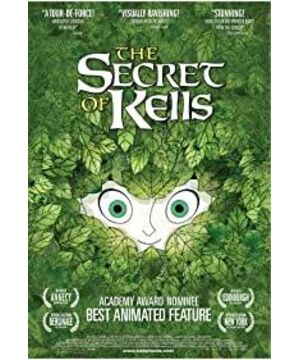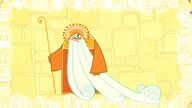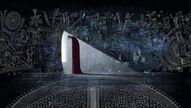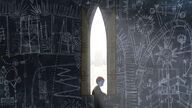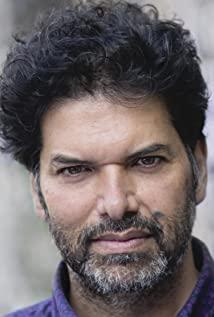In The Selfish Gene, man is said to be a culturally-bred animal, so culturally dependent that man's behavior "is not strictly but only very broadly determined by genetic programs or patterns—intrinsic information Source-controlled, the extreme generality, diffusivity, and variability of man's innate responsiveness suggest that the particular type of behavior he assumes is primarily guided by cultural, rather than genetic, templates."
The background of this animated work "The Secret of the Book of Kells" is set in the European Middle Ages. Since I don't know much about European history, I will briefly talk about my cultural understanding at that time. The mainstream culture at that time was Christianity, and other types of non-Christian believers were called "pagans". The Book of Kells in the animation is a manuscript of the Gospels of the Bible written in Latin.
The story takes place around the end of the 8th century when pirates began to attack the island of Ireland. In 836, when the monastery was destroyed, some monks fled to the European continent with manuscripts, and ancient Irish literature was preserved. There are many different views on what this animation expresses on the Internet. Some people think that this is an animation that promotes the traditional Irish civilization, which is intended to let people understand the origin of Irish culture, while others think that it is a reference to various religions. A kind of cultural diversity discussion of cultural hybridization, which believes that civilization is a new civilization derived from the continuous process of destruction, and the new civilization is derived from the personal choice of the "early bird".
I personally think that people's view of self-consciousness mainly comes from the existence of traditional culture. We live in a context and it is impossible not to be affected by this context. Even if you don't agree, there will be more or less value biases. Shift, people are part of culture. However, in the post-modern context, traditional cultural values and concepts have collapsed one by one, and the utilitarianism and pragmatism promoted by "instrumental rationality" have increasingly penetrated into everyone's life. In a postmodern context, there is no truth, no reality, and no meaning.
Utilitarianism or the decision of a "early bird" is a personal choice, and whether there is a value judgment behind the personal choice. And the reason why such value judgments are born comes from what he believes, in other words, beliefs are the source of personal choices. Of course, what this animation emphasizes is religious belief, and religious belief corresponds to absolute authority. Authoritative language makes people's beliefs unshakable and deeply rooted in people's thoughts. Most of the people in the animation are Christian believers, including the male protagonist Brendan, but I think religious beliefs and individual beliefs can be separated. Although there is no denying that there will be some fusion of the two, there is an individual behind each person's choice. manifestation of faith .
Behind the stubborn persistence is the belief in "ignorance"
Brendan's uncle Albert once said to the painter Aidan, that is not my personal wall, Aidan, it is a wall that can save civilization, a wall that can save your book! The pagans, the krom-worshippers, believed in the indestructible power of our faith because of the indestructibility of our walls. It sounds familiar. This sentence has a similar presentation effect in "Attack on Titan". The belief of most people in the wall of giants is to give their hearts for the country, and Albert's belief is the height of the wall The higher you are, the stronger your sense of security. He summed up spiritual values in physical sense.
The beliefs mentioned by Albert may not seem to be a problem, but when you think about it carefully, there is a kind of logical confusion. His logic is upside down . The "solidity" of belief does not need to depend on the solidity of the wall, because spiritual power and material are not at the same level. Such a statement obviously stands on the standpoint of "utility" rather than "spirit". Albert put his own erroneous logic in the absolute position of spiritual needs, even in life and death, he did not give up the pursuit of spirituality. Of course, as I said before, the theme of this animation involves religion, which means that the absolute position of the spirit is desirable in the social environment at that time, which can explain Albert's approach.
If we look at Albert’s current situation in the current context, his behavior is no different from “ignorant” behavior, which may be arrogant. We are only in modern society and have a new set of value judgments. And Albert's value judgment at that time largely depended on his belief in Christianity. From the animation, it can be inferred that Albert is not shaken by anyone's values, he has always been his own values. I have to mention here that the monastery mentioned many times in the animation is not the kind of monastery that takes in orphans, or a monastery with only a single function, but a kind of "sanctuary" that continues the traditional Irish civilization. ”, and monasteries with this function were common at that time, and they also took into account the function of sheltering refugees at that time, so in a sense, the world inside the wall symbolized a piece of Irish civilization. Utopia.
Is it a "belief" in ignorance that Albert still chooses to keep everyone inside the wall at the stall that the Vikings attacked?
In the animation, Albert is the abbot of the monastery, the "god" in the spiritual utopia, which means that his words represent the absolute authority of the local area. Therefore, when Brendan was unwilling to follow Albert's will many times in the animation, Albert put him in the basement for him to reflect, and repeatedly warned Brendan not to leave the wall, the outside world would not Safety. And his basis for insecurity mainly comes from the invasion of Vikings, and the fear of invasion makes him biased to think that all places are insecure, and only the world inside the wall is their spiritual home. The function of the wall is to save civilization, to hold hope.
The ignorance I mentioned here is a judgment of Albert's behavior in a modern context, at the time, his behavior was absolute and unquestionable, which in itself is nothing to discuss, I don't think this is animation either The value judgments passed on to us. As for my own approach to Albert, I believe that his inherent impression of civilization caused his ignorance.
Not his own ignorance, but his ignorance. First of all, what we need to understand is that Albert himself was a scripture painter before, and Aidan, another scripture painter who appeared in the animation, is famous far and wide. The reason why he is known to the general public is that he painted scriptures. The style has local cultural characteristics, that is to say, the painter is the promoter and disseminator of traditional culture, and the reason why Albert did not continue this work is because he used another belief to protect civilization.
There are two means of cultural communication in animation, one is based on books, and the other is based on physical objects (Albert's Abbey). There are no advantages or disadvantages in the means of cultural communication. In a sense, Albert's insistence on his beliefs is a good starting point, so in the animation I just call him a stubborn old stubborn, not a bad person.
It can be said that his belief itself is rooted in his own spirit. To put it mildly, it is called the guardian of civilization, and in other words, it is called the selfish master. It is mentioned in the animation that Aidan tried to communicate with him that his approach was also a continuation of civilization, and in Albert's eyes, there can only be one way to protect civilization, and it can only be the one that favors him. He can't tolerate the emergence of another cultural communication phenomenon, and his approach is a little more "ignorant" of loneliness and his own arrogance.
The belief in "ignorance" is reflected in two aspects, one is to be indifferent to the opinions of others, and the other is to insist on the absoluteness of one's own judgment. He blocked all the input and output calibers, and all that was left was the empty echoes in his heart. Because of his belief in "ignorance", the refugees stayed within the walls and were slaughtered by the Vikings, and the spiritual utopia could not be a hell of primitive acts of savagery,
In other words, Albert's attitude towards the world is too idealistic. He completely projected his "ignorance" into the world. He narrowly believes that his beliefs are correct, so that he requires everyone to be in sync with his beliefs. It is the main reason and objective fact that caused heavy casualties inside the wall. There are no high or low beliefs, but if the results of belief are terrible, then I think this is "ignorant belief". (Of course it also has its meaning.)
The pursuit of "true knowledge" is for the belief in "brightness"
The belief in "light" I mentioned here is actually a belief in truth. In the social environment at that time, the truth widely admired by the public was an extension of the Christian teaching. Although Brendan is also a Christian, he has always viewed his own beliefs from a dialectical perspective. Compared with his uncle, his beliefs are more fluid. The fluidity here is not meant to be derogatory. The "Eye of Columbakler" appeared in the animation. This crystal stone is the most important tool for drawing the Book of Kells. It is located in the dark part of the forest, and Brendan's exploration of tools has a certain significance. Above is a metaphor for the active search for knowledge in darkness and shadows.
Brendan's belief in the search for truth actually stemmed from his spiritual mentor, Aidan. Aidan once told Brendan that without books, all knowledge would be lost, forever. Therefore, Brendan's yearning for knowledge is extremely strong. In his view, knowledge is true knowledge and the light of the time, which he must grasp and constantly explore. When Aidan told him that subtle knowledge required the "Eye of Columbakler" - a magical crystal stone, which was Kromkuru (the eye of a serpent), the god of darkness. The symbolism presented in the animation is very obvious. According to Heidegger, knowledge (truth) exists in obscurity and obscurity, and can only be obtained through people's efforts. Those who fight and win.
Beings are pulled out of their obscure state. The actual state of revelation always seems like a robbery. Is it accidental that the Greeks used a depriving word (uncovering) when speaking about the nature of truth? "If you don't forget Ashling's last words after she sacrificed herself to lift the boulder for Brendan in the animation: "turn the darkness into light", the symbolic meaning will be more obvious, and the knowledge that Brendan wants to get is to " The existence is revealed from the obscure state, making it "uncovered" and becoming light. The image of the god of darkness (Montanacon), who symbolizes the existence, is not a concrete animal in the animation, but an abstraction. Expressed by the integration of lines and symbols, Brendan can therefore use a circle surrounded by an arc to prevent its fierce attack and restrict its range of activities, (the power of knowledge), so that we can associate "existence-- Scope-Concept" is a process of knowledge acquisition.
Expressed through animation, true knowledge is usually hidden in the dark and dark, and Brendan just became the "exposure person", presenting the difficult knowledge in another way of bearing. This is his belief, Belief in "light" (the pursuit of true knowledge). I think there is another important reason for Brendan to make such a "stupid" decision, and that is critical thinking about absolute authority. As his uncle, Albert is the absolute authority of the local area. It is not that he has not instilled his ideas in him, and even let Brendan study architecture by his side every day, in order to increase the density of the high wall, in a sense Above all, Albert understands how to bring people into submission, and that is education, and Brendan is naturally rebellious.
Doubt about absolute authority made him not blindly accept his uncle's values, but kept trying to use his own values to perceive the world and dispel doubts and store the truth. The opening remarks in the animation once said, I have seen the suffering and suffering in the dark, and I have also witnessed the vibrant beauty of the fragile earth. I saw the book, the book that dispelled the darkness and opened the light. "
Although this is the opening narration, I prefer it to be Brendan's inner monologue. I said earlier that when he didn't know Aidan and saw the Book of Kells, his beliefs were fluid, And the node where he chooses to strengthen a belief is that he decides to use his own search method to open up "light", and the power of belief in light has always been the most effective external force to dispel the haze.
The beliefs of the pagans seem sad, but in fact they are the most "reliable"
In fact, the animation is not simply about the traceability and questioning of religion, but it wants to convey to us the origin of Irish culture. On the one hand, it traces the history. The Book of Kells was born in a period of multicultural integration in ancient Ireland, where the boundaries between Christianity and paganism were sensitive and fragile; Only then can human civilization and national culture be inherited and developed. Here, religion is just a cultural symbol, a carrier for the director to express his national cultural feelings. The pagans mentioned in it are the forest culture represented by Ashling (advocates of Druids).
Druids were wizards of Celtic and Irish ancestors, in charge of witchcraft and scholarship. In Roman and Greek mythology, Druid means the goddess of the forest. There was Druidism in the past, but now it has basically disappeared. Their followers are often said to be able to transform into animals such as wolves and bears (Ashiling's self-report at the beginning of the animation). Druids are worshipers and defenders of nature. , oaks and acorns are their relics (berries in slices). And the Celts have a characteristic, that is, they were matriarchal clan societies in the early days, and women were usually druids.
In the animation, the symbolic meaning of Ashiling is not clear. The background introduction given by this netizen just sums up that Ashiling is a "god" of Druidism, has the support of believers who can be transformed into wolves, and at the same time she herself The body is the white wolf. So why call Ashling a heretic? The other characters in the animation except Ashling are all Christian believers, and Christianity, as the mainstream culture of society at that time, naturally did not allow other voices to be heard, so that Christianity wanted to assimilate non-Christian (pagan) ideas, and it was also at the beginning. From the beginning of the cooperation, the advanced ideological individuals represented by Brendan began to use books as a carrier to promote Christianity, and when he grew up, he met Ashiling again, but Ashiling at that time had changed back again. The white wolf can no longer speak. It is a metaphor for the heathen's eventual assimilation (unable to speak) and expulsion (migration to the forest).
It can be seen that, as the "God" of the pagans, Ashiling is naturally the first object to be assimilated, and has mastered the right to speak of "God" in order to assimilate more pagans. So what did the pagans believe in? I think from the very beginning of Ashiling's attitude towards Brendan, they followed a kind of ecologicalism based on nature, which has something in common with Japan's animism advocating nature, and it also confirms the culture from the side. It's the same all over the world.
The forest world presented to us by the animation is completely different from the human world. What is hidden in the forest is the unknown, powerful and a kind of natural force, which are all feared by human beings. The most primitive darkness breeds the phenomenon that the same world does not allow multiple voices to exist.
But Ashiling's beliefs are extremely solid. What she uses is not high-pressure spiritual domination and rigid ideology, but the power of nature to bring people together. Their beliefs start from the heart and are recognized by everyone. A kind of natural culture that does not need to be restrained by artificial force, just let it run naturally and naturally extend the culture. Such beliefs are undoubtedly different from the beliefs presented in the animation. What Brendan believes in is a set of critical dialectics that have been operated by human society for hundreds of years, while Ashling's beliefs seem to have no foundation. Prison, in fact, is the most free state under the natural operation.
There are naturally thousands of interpretations of freedom. I myself prefer freedom that lacks external constraints and does not have to pay a high price, a state of mind. Therefore, in the animation, we can see that the attitude of Ashiling's black wolves towards Ashiling is in sharp contrast with that of the believers in the wall towards Albert. The feelings conveyed by the two different beliefs are completely different. She is too anxious about the inheritance of civilization, but Ashiling is more indifferent and calm, so what if she is removed from the mainstream view? What if you can't speak? The beliefs we adhere to are free, and naturally they will not be affected by the external environment. One day, the civilization they guard will be attacked like the giant python.
View more about The Secret of Kells reviews


